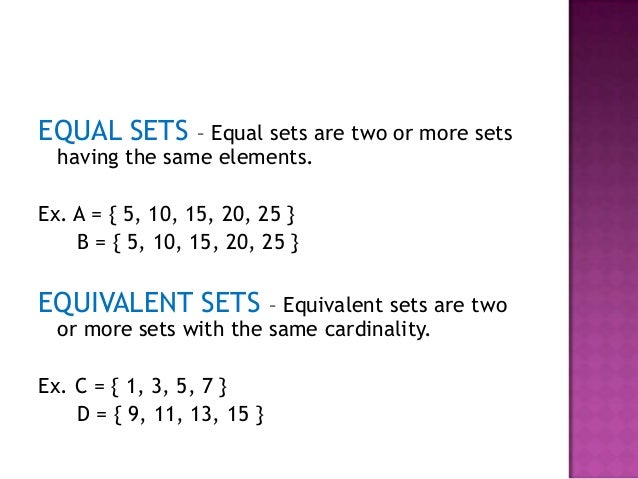- equal in value, amount, function, meaning, etc."one unit is equivalent to one glass of wine"
- 1.a person or thing that is equal to or corresponds with another in value, amount, function, meaning, etc."the French equivalent of the Bank of England"
- 1.being the same in quantity, size, degree, or value."add equal amounts of water and flour"
Lesson Title: Understanding Equivalent and Inequivalent Sets
Grade Level: 6
Duration: 1 Hour
Strand: Sets
Focus Question: What are the special symbols and language I use when I work with sets?
Objectives:
-
Associate the members of a set with the properties of that set.
-
Distinguish between equivalent and equal sets.
🌟 5E Lesson Model Plan
1. Engage (5-7 minutes)
Activity: "Mystery Bag Challenge"
-
Teacher presents two "mystery bags" (physical or virtual) each with 4 random classroom objects.
-
Students describe the objects and determine whether the bags have the same number of items and/or same items.
-
Use this to introduce the terms:
-
Equivalent Sets: Same number of elements.
-
Equal Sets: Same number and identical elements.
-
❓ Ask: “How can we describe sets that have the same number of items but not the same items?”
🔤 Highlight key vocabulary: Set, element, cardinality, equivalent (∼), equal (=), inequivalent
2. Explore (10-15 minutes)
Activity: “Set Sorting STEM Task”
-
In small groups, students are given a mix of image cards or objects related to STEM themes (e.g., types of energy sources, simple machines, planets, geometric shapes).
-
Students group them into sets based on criteria (e.g., color, type, shape, use).
-
Then they compare sets:
-
Count elements in each set.
-
Use symbols to label:
A ∼ B (equivalent), A = B (equal), A ≁ B (inequivalent)
-
Materials: Printed cards or virtual slides with items, Venn diagrams, Set symbol posters.
🧠 Observation: Which sets are equivalent? Which are equal? Which are neither?
3. Explain (10 minutes)
Mini-Lesson + Notes:
-
Define:
-
Set: A collection of distinct objects.
-
Equivalent sets: Sets with the same number of elements. (Symbol: ∼)
-
Equal sets: Sets with the same elements. (Symbol: =)
-
Inequivalent sets: Sets with different numbers of elements. (Symbol: ≁)
-
-
Use examples from previous activity.
-
Highlight symbols and language used with sets.
💡 Write on board:
Set A = {1, 2, 3}, Set B = {a, b, c}, Set C = {1, 2, 3}
➤ A ∼ B, A = C
4. Elaborate (15 minutes)
Activity: “Set Scenarios - Real-World STEM”
-
Students complete a worksheet with scenarios (see examples below).
-
For each pair of sets, students must:
-
List the elements.
-
Determine whether the sets are equal, equivalent, or inequivalent.
-
Justify with a sentence using appropriate language/symbols.
-
Example Scenarios:
-
Set A: planets in the solar system | Set B: days of the week
-
Set C: types of energy (solar, wind, thermal) | Set D: {wind, solar, thermal}
🧠 Extension/Challenge: Students create their own sets from a STEM topic (e.g., animals with vertebrae vs. invertebrates) and compare them.
Differentiated Support:
-
Tier 1: Use concrete objects or drawings.
-
Tier 2: Provide sentence starters and vocabulary support.
-
Tier 3: Students create and compare abstract sets independently.
5. Evaluate (10 minutes)
Three-Tier Evaluation Task
| Tier | Activity | Focus |
|---|---|---|
| Tier 1 | Match sets with symbols: ∼, =, ≁ | Recall and identification |
| Tier 2 | Complete chart with sets and explain the relationship (equivalent, equal, inequivalent) | Understanding and explanation |
| Tier 3 | Create 2 original sets: one that is equivalent but not equal, and one that is inequivalent; justify each | Application and analysis |
🌱 STEM Integration
-
Sets drawn from Science (e.g., organs, planets, types of energy), Technology (e.g., devices, apps), Engineering (e.g., simple machines), and Math (e.g., types of angles, polygons).
-
Students are encouraged to apply logical reasoning, categorize, and model their thinking using set notation.
✏️ Materials Needed:
-
Mystery bag items or cards
-
Worksheets/slides
-
Markers, chart paper, or digital whiteboard
-
STEM-themed item cards or images
-
Vocabulary posters with symbols: =, ∼, ≁
🔁 Wrap-Up (2-3 minutes)
-
Recap focus question:
“What are the special symbols and language I use when I work with sets?” -
Ask for quick oral examples: “Give me two sets that are equivalent.”
-
Share one new thing they learned today.


Good night miss it's Sanoya way ahead of you on sets, these activities are so fun ☺️😊❤️❤️🩷💓💗💗💓🩷💓🩷💓💗❤️👍👍👍👍😁😁😁😁😁😁☺️☺️☺️☺️☺️😊😊😊😊
ReplyDeleteGood night miss it's Sanoya these activities are so fun 😊💞🩷❤️💗💓🩷🩷♥️♥️❣️❣️❣️❣️💕💕💕💕💞💞💞💞
ReplyDeleteGood evening miss it's Sanoya these activities on sets are so 👍🙂❤️♥️💞
ReplyDeleteHi miss. The work is so much fun.❤️❤️❤️❤️❤️❤️❤️❤️❤️👍👍👍😁😁
ReplyDeleteHi miss. The work is so much fun. I really love it.❤️❤️❤️❤️❤️❤️❤️❤️❤️❤️❤️❤️❤️❤️❤️❤️❤️❤️❤️❤️❤️❤️❤️❤️❤️👍👍👍😁😁
ReplyDeleteHi miss it's Sanoya these activities on sets are so 🙂👍💕💕💗♥️❤️💓💞🩷🩷
ReplyDeleteLove these activities
ReplyDeleteHi miss it's Natalia I love these activities so much
ReplyDeleteHi miss this activity is so fun i love it so much
ReplyDelete💕💕💕💕💕
ReplyDeleteHi miss the activity is so fun i love it
ReplyDeleteCan you teach us more please we love it
ReplyDeleteMiss you should give us more we love it
ReplyDeleteMiss i did the work
ReplyDeleteI did the work
ReplyDeleteMiss i love this work💕
ReplyDeleteHi miss I did the work I love it 💕💕
ReplyDeleteHi miss. The work is so much fun.
ReplyDeleteHi miss I love the work.😄😁💕💕💞💞
ReplyDeleteHi miss. The activities are so much fun❤️❤️❤️💕💓💞🩷💗💖💝😁😁👍👍
ReplyDeleteHi miss .I love these activity
ReplyDelete